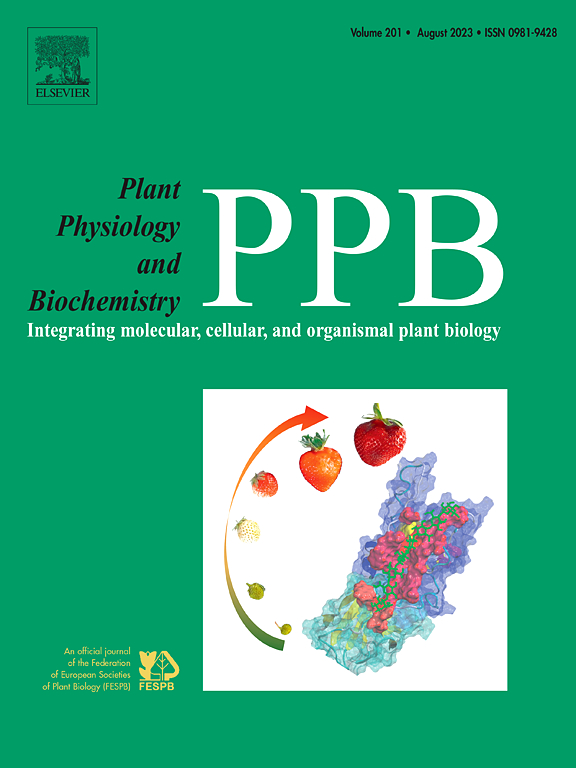Functional analysis of apple defense protein MdACBP and screening of interacting proteins with Penicillium expansum
IF 5.7
2区 生物学
Q1 PLANT SCIENCES
引用次数: 0
Abstract
As the primary fungal pathogen of apple (Malus domestica) blue mold, Penicillium expansum severely affects the post-harvest quality of apples. Protein–protein interactions play a crucial role in plant resistance to biotic stress. Here, we re-analyse the previously obtained proteomic data from apples infected with Penicillium expansum and identify numerous differentially expressed proteins that may significantly contribute to their defence mechanisms. The MdACBP protein is expressed during the defence response of apples against P. expansum infection and exhibits a high binding affinity for acyl-CoA and phospholipids, suggesting a crucial role in the apple defence mechanism. In this study, through bioinformatics analysis, subcellular localization, yeast two-hybrid assays, and interaction site prediction, we identified MdACBP as a member of the ACBP1 family, localised in the cytoplasm. During P. expansum infection, MdACBP interacts with A0A0A2IS21 (Pe25) with a confidence score of 0.8783. In conclusion, our findings suggest that MdACBP and Pe25 act together to defend against P. expansum infection in apples, providing a theoretical basis for the prevention of P. expansum induced blue mold in apples.
苹果防御蛋白MdACBP的功能分析及与膨胀青霉互作蛋白的筛选
膨胀青霉是苹果蓝霉病的主要病原菌,严重影响苹果采后品质。蛋白质-蛋白质相互作用在植物抵抗生物胁迫中起着至关重要的作用。在这里,我们重新分析了之前从感染了扩张青霉的苹果中获得的蛋白质组学数据,并确定了许多可能对其防御机制有重要贡献的差异表达蛋白。MdACBP蛋白在苹果对扩张葡萄球菌感染的防御反应中表达,对酰基辅酶a和磷脂具有高结合亲和力,表明其在苹果防御机制中起重要作用。在这项研究中,通过生物信息学分析、亚细胞定位、酵母双杂交实验和相互作用位点预测,我们确定MdACBP是ACBP1家族的成员,定位于细胞质中。在扩张芽孢杆菌感染过程中,MdACBP与A0A0A2IS21 (Pe25)相互作用,置信度为0.8783。综上所述,MdACBP与Pe25共同作用于苹果中,可为苹果蓝霉病的防治提供理论依据。
本文章由计算机程序翻译,如有差异,请以英文原文为准。
求助全文
约1分钟内获得全文
求助全文
来源期刊
CiteScore
11.10
自引率
3.10%
发文量
410
审稿时长
33 days
期刊介绍:
Plant Physiology and Biochemistry publishes original theoretical, experimental and technical contributions in the various fields of plant physiology (biochemistry, physiology, structure, genetics, plant-microbe interactions, etc.) at diverse levels of integration (molecular, subcellular, cellular, organ, whole plant, environmental). Opinions expressed in the journal are the sole responsibility of the authors and publication does not imply the editors'' agreement.
Manuscripts describing molecular-genetic and/or gene expression data that are not integrated with biochemical analysis and/or actual measurements of plant physiological processes are not suitable for PPB. Also "Omics" studies (transcriptomics, proteomics, metabolomics, etc.) reporting descriptive analysis without an element of functional validation assays, will not be considered. Similarly, applied agronomic or phytochemical studies that generate no new, fundamental insights in plant physiological and/or biochemical processes are not suitable for publication in PPB.
Plant Physiology and Biochemistry publishes several types of articles: Reviews, Papers and Short Papers. Articles for Reviews are either invited by the editor or proposed by the authors for the editor''s prior agreement. Reviews should not exceed 40 typewritten pages and Short Papers no more than approximately 8 typewritten pages. The fundamental character of Plant Physiology and Biochemistry remains that of a journal for original results.

 求助内容:
求助内容: 应助结果提醒方式:
应助结果提醒方式:


